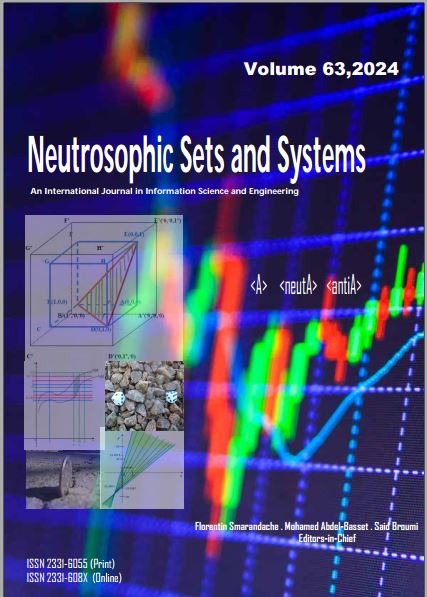Neutrosophic Linguistic valued Hypersoft Set with Application: Medical Diagnosis and Treatment
Keywords:
Indeterminacy, Uncertainty, Neutrosophic set, Linguistic quantifiers, linguistic set, hypersoft set, aggregate operators, multi-criteria decision-making (MCDM)Abstract
Language is closely connected to the concepts of uncertainty and indeterminacy, as it functions as a fundamental tool for the expression and communication of information. Linguistic formulations possess inherent qualities of ambiguity, imprecision, and vagueness. The comprehension of language frequently hinges upon contextual factors, individual interpretation, and
subjective viewpoints, resulting in ambiguities in comprehension. Neutrosophic-linguistic valued hypersoft sets (N-LVHS) play a pivotal role in decision-making by effectively managing linguistic uncertainty, modeling real-world complexity, and accommodating multidimensional information. In the realm of medical diagnosis and treatment, several limitations tied to language and indeterminacy persist. Patients often use vague or imprecise language to describe their symptoms, complicating the
accurate identification of ailments. Moreover, diagnostic criteria are subjectively defined, leading to inconsistencies in diagnoses. Disease progression, characterized by its complexity and unpredictability, adds further indeterminacy in treatment planning. The variability in patient responses to treatments introduces uncertainties in outcome prediction. Inconclusive test results and
limited clinical data may compound these challenges, underscoring the need for innovative approaches like N-LVHS to address these linguistic and indeterminacy-related limitations and improve the precision and efficacy of medical decision-making and treatment procedures. In constructing an N-LVHS framework for medical diagnosis and treatment, relevant factors, and linguistic terms characterizing medical conditions and treatments are identified. For example, disease severity could be described using terms such as "mild," "moderate," and "severe," while treatment effectiveness may be categorized as "low," "moderate," and "high." Each factor is then assigned neutrosophic values based on their measured impacts. This approach provides a more precise representation of the complex medical diagnostic and treatment landscape. The findings of this study have the potential to assist medical practitioners, researchers, and policymakers in optimizing medical diagnosis and treatment strategies, enhancing patient outcomes, and improving healthcare practices.
Downloads
Downloads
Published
Issue
Section
License
Copyright (c) 2024 Neutrosophic Sets and Systems

This work is licensed under a Creative Commons Attribution-NonCommercial-ShareAlike 4.0 International License.








